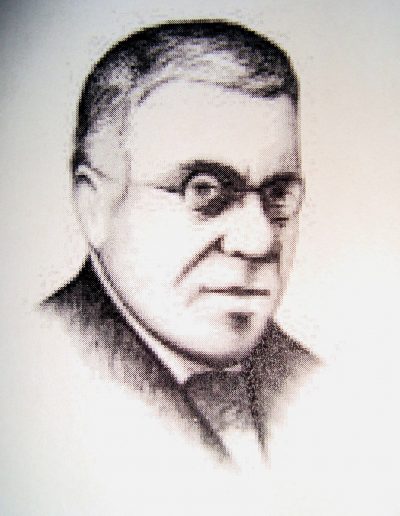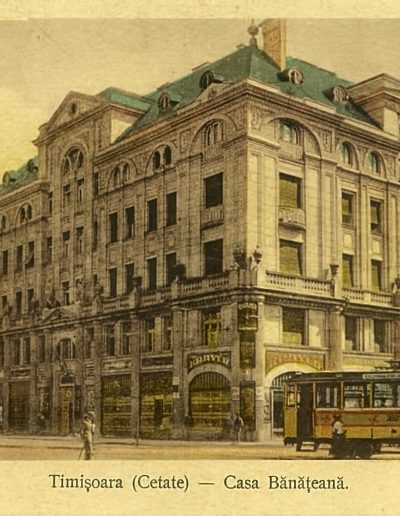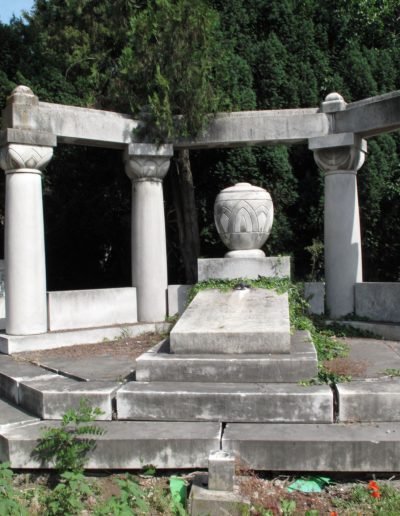Zsigmond Szana
June 23, 1870, Timisoara - May 24, 1929, Chicago, buried in TimisoaraIndustrialist, banker, author
Szana, the Hungarianized name of Silberstein, was one of the most prominent bankers, industrialists and philanthropists not only in Timisoara, but also in Southern Hungary. After studying at the Commercial Academy in Budapest and at the College of Commerce in Berlin, back in Timisoara, his first serious investment was the First Match Factory, established in the Josephine district by Károly Steiner jr. in 1883 and, after Szana took over, considered the largest match factory in Hungary.
In 1906 he founded S.A. Banking and Commercial (Temeswarer Bank und Handels AG), known as Timişoara Bank or Szana Bank from Timişoara, which played a decisive role in the economic life of Banat by setting up industrial enterprises. Szana Bank was involved in the development of local industry, controlling enterprises "Industria Lânii" (ILSA), Chocolate Factory "Kandia", factories "Lumina" and "Dura SA" (future "Electrobanat"), Brewery, Mill "Bega" and other. In the first decades of the twentieth century it was considered the most important financial institution in southern Hungary, and after Trianon, in Transylvania and Banat.
Szana Palace (or Banat House, Banat Palace), the bank's headquarters, was built on the site of the Roman Catholic Church of St. George, one of the oldest buildings in Timisoara, attested since 1322. The church survived the Muslim occupation, during which time it was turned into a mosque. At the end of 1914, both the church and the building next to it, the Theological Seminary, were demolished. Szana Bank built in 1921, according to the project made by the architect Josef Kremer Jr., as the headquarters, the building in the shape we see today. It is an eclectic style construction, with Secession elements and some details that announce the Art Deco style. From the date of construction until now, the building has housed the headquarters of various institutions, such as: "Adriatica" Insurance Company, "Balcan Impex" Company, Banca Timişoarei SA, "Consulate of Great Britain" (1923), Romanian Association for Relations with the Soviet Union, "ARLUS", (ca. 1950); The editorial house of the magazine “Orizont”, etc.
In 1908, Szana was elected president of the Banat Industrialists Association. He was named honorary consul of England in Timisoara. In 1913-1914 Szana ran the Vienna branch of the Anglo-Hungarian Bank, and in 1920 the Gea SA branch in Budapest.
He financially supported organizations, associations and educational institutions, being among the founders of the Association "Amicii Muzicii (Friends of Music)" in Timisoara. He was one of the associate presidents of S.A. Casa Maghiară (Hungarian House) from Timişoara.
He died of a heart attack in Chicago on May 24, 1929, during a business trip. His funerary monument in the Jewish Cemetery in Timişoara was made by the sculptor Ferenc Medgyessi (1881-1958), made of Ruşchița marble.
The figure of Sigismund Szana served as a model for Livius, a character in the novel The Red Rider (Der Rote Reiter) by the German writer Franz Xaver Kappus.
Publications
Szana published German short stories in two volumes in his youth, and later a pamphlet on Beethoven. Szana wrote several pamphlets in the financial field in Hungarian, such as Az ipari záloglelekről (On Industrial Land Documents) and A háboru kihatása a pénz lenyegére (The Effects of War on the Essence of Currency).
Bibliography
- Szekernyés János, A magyarság emlékjelei a Bánságban, Temesvár, 2013
- Sigismund Szana on wikipedia.ro
https://ro.wikipedia.org/wiki/Sigismund_Szana - Mapping historical monuments on the website of Timişoara City Hall, No. ref. 165, p. 198
http://www.primariatm.ro/uploads/files/cartare_cetate/40%20-%20Cvartal%2029-30.pdf - FORGOTTEN TIMIŞOARA The history of the first spiritual, financial and cultural center of the city By Liana Păun - Feb 9, 2014
http://www.pressalert.ro/2014/02/timisoara-uitata-care-era-centru-spiritual-financiar-si-cultural-al-orasului-urma-cu-doua-secole/


